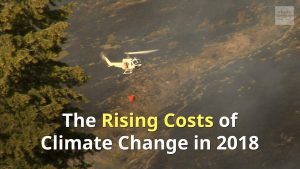The costs of climate change in 2018 rose significantly. Climate change is increasingly costly, especially in the U.S. And, its man made nature is increasingly clear.
On the current trajectory the world will be 4° to 5° hotter by the end of this century than it was before the industrial revolution. Although this may not sound much, only about 1° of warming has taken place so far. So, we must expect far more severe storms as the years go by! Inevitably, that is going to raise the costs of climate change. (Source: New Civil Engineer, April 2018)
Watch our Rising Costs of Climate Change intro video (below) to bring yourself up to speed on this subject, and return to SCROLL DOWN this page where we have a lot more interesting info for you!
< Coming Soon! >
Residents of California, Puerto Rico, and Texas will need no reminder that the climate was unusually cruel in 2017.
But now official statistics are putting those fires and storms, and the rapidly rising costs of climate change in perspective.
The United States was struck by 16 climate and weather disasters that each caused at least a billion dollars in damage.
2017 now matches 2011 as having the greatest number of billion-dollar disasters.
But 2017 blew through the previous record for the cumulative cost of these events.
Losses in 2017 exceeded $306.2 billion, well above the $214.8 billion in losses during 2005 (values are adjusted for inflation).
The above is based on a C2ES article on the connection between climate change and extreme weather.
 Explore the Centre for Climate and Environmental Solutions' (C2ES) resources on extreme weather.
Explore the Centre for Climate and Environmental Solutions' (C2ES) resources on extreme weather.
At www.c2es.org or click to visit.
For your video creation, visit ippts.info and request a free quote.
Rising Costs of Climate Change Climate Change 2018 Costs U.S. Billions in Storm Damage
Extreme weather events caused $306 billion in damages in the United States in 2017. Hurricanes, wildfires, flooding, mudslides and drought were exacerbated by climate change. The effects of climate change are a drain on our economy.
$306 billion is a pretty big number to wrap your head around. To give it some context, it would cost only $2 billion, a small fraction of the disaster relief costs, to retrain every coal worker in the U.S. to solar jobs. Or to relate to local figures, recently the Lehigh Valley applied for a total of $10 million in federal grant monies to improve transportation (it was awarded just more than $1 million).
So what could we as a nation do with $306 billion? We could certainly improve infrastructure, upgrade our energy grid, expand public transportation, and make our cities more resilient.
How do we avoid paying the rising costs of extreme weather events (aka the rising costs of climate change)? We limit carbon emissions. via Climate costs U.S.
Insurance claims due to climate change-related disasters reached a record $135 billion in 2017. That should be a big wake-up call to the insurance industry, says Carbon Tracker CEO Anthony Hobley via Climate Price is Rising
An agency of the United States government says the effects of climate change cost American taxpayers billions of dollars each year.
The U.S. Government Accountability Office, or GAO, investigates how the federal government spends tax money.
In a new report, the GAO tries to estimate the amount of federal money spent on disasters related to climate change.
The agency considered the possible economic effects of slowly rising temperatures in Earth’s atmosphere and risks to the government. It used information about possible weather conditions based on climate models.
A study from the National Research Council notes how large numerical models have become an important tool for climate scientists. Computer programs turn information about the physical world, such as chemical and biological processes, into mathematical operations resulting in figures which predict the rising costs of climate change.. via US Agency: CCCostsUSBillions
Humanitarian costs of climate change unpredictable
New projections of the impact of climate change make headlines every day, but a report by a leading research institution has underlined the need for “meaningful data” to help aid agencies prepare for the future.
 The report by a group of researchers at the Feinstein International Centre of the US-based Tufts University uses various models to project the likely rise in humanitarian spending over the next 20 years as the frequency and intensity of natural disasters increases.
The report by a group of researchers at the Feinstein International Centre of the US-based Tufts University uses various models to project the likely rise in humanitarian spending over the next 20 years as the frequency and intensity of natural disasters increases.
But Peter Walker, director of the centre and one of the researchers, said the point of the report was not to say, “This is what the future will be … rather it is to say, ‘Stop making wild and sensationalist predictions and admit the real problem is that we have been negligent in the data we collect, and so have placed ourselves in a situation where we are hard-pressed to say anything meaningful about what the future will look like.'”
Natural disasters affect an average of more than 250 million people per year; since 1992, nearly US$2.7 trillion has been spent on international responses to cyclones, floods and droughts in at least four regions of the world – South-East Asia, India and the neighbouring states, East Africa and Central America – the Feinstein report notes.
The future is “inherently unpredictable”, and aid agencies have “to let go of their old comfortable linear models of change” and become “adaptive, flexible, and open to acting upon feedback”, said Walker. via Humanitarian costs
“The scientific evidence for anthropogenic climate change has strengthened year by year,”
said Qin Dahe, a climatologist at the Chinese Academy of Sciences. He is also is co-chairman of the working group preparing the panel’s report.
The accumulating evidence, he said, leaves:
“fewer uncertainties about the serious consequences of inaction.”
via CostCChange








For better savings on your utility bill, keep your solar panels clean. Solar panels are practically silent and since you don’t touch them, you can easily forget them. The cleaner their glass panels are, the more clear surface area the sun has to “work with.” There’s no set amount of time that you should clean them. If you live in an area with lots of wind, dust or construction, they may need cleaned frequently. Some ares may require weekly cleanings.
Are you looking for a way to reduce your carbon footprint on the earth? It seems as though more and more people are doing this. Have you ever thought about using solar energy to power your home, pool or even just light up your yard after dark? Solar energy is both an economical and environmentally smart choice.
“THINK ABOUT IT. lol we’re all going to be roasted, drowned or crushed”
Yes i belive he is absolute correct.
Yes i belive he is absolute correct.
Yes. Huge costs if we don’t sort this one out bloody soon!
“Heck. lol” we’re all most likely to be infected. Will we die?”
I did not like slow videos your video is best and very innovative?
The ideas you have are right…. We must keep earth clean